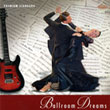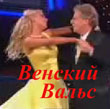 |
The best Waltzes from Europe |
|
|
Character
Slow lyrical dance with it is very characteristic expressed and constantly repeating "накатной a surf wave", making impression of flight, weightlessness and romanticism. Movements sliding, soft, свинговые (pendulum). Parallelism of feet. It is often enough used противодвижение cases.
Lifting and Decrease
Lifting in the end of 1 begins, lifting on 2 and 3, decrease in the end of 3 proceeds.
Steps and rhythm
As a rule, on each step it is necessary three steps (one step on one blow of music). In the advanced figures there can be 4-6 steps to a step, turns and rotations that does a slow waltz by dynamical enough dance. Slow steps and позировки, giving to dance the big expressiveness are used also.
Dance history
Slow waltz – the descendant of the Viennese waltz. The Viennese waltz was often criticised for too fast, exhausting rate, indecently close position of partners and constant rotations. There was gradually slower music for waltzes and a new kind of a waltz – бостон (or the American waltz), with slower turns and longer, sliding movement.
Approximately in 1874, in England, "the Boston Club" was formed very influential and new style of dance (occurred from dance бостон) – the English named subsequently a slow waltz (Slow Waltz) has started to appear.
In 1921 conference on which official rules for various dances have been defined has been spent to England. For a slow waltz the closed position has been left, and the program consisted only of the right and left turns and change. And though it was strange enough that popular dance was regulated by council, but the result has surpassed all expectations – dance has turned out beautiful, graceful and gentle.
In 1926-1927 the waltz has been considerably advanced. The basic movement has been changed on «a step, a step aside, a prefix». As a result of it has appeared more possibilities for development of figures. They have been standardised by the Imperial Society of Teachers of Dance (ISTD).
By 1929 the slow waltz was definitively issued. The special contribution to waltz modernisation the Steward and Pet Sykes – the first English world champions on ballroom dances have brought Zhozefin Bredli, Victor Silvestr, Maksvell. Many of the variations, entered dancing use at that time, are executed till now at competitions of ballroom dances. The history has not forgotten to note a merit of Englishmen in development of the Slow Waltz, its second name – the English Waltz.











